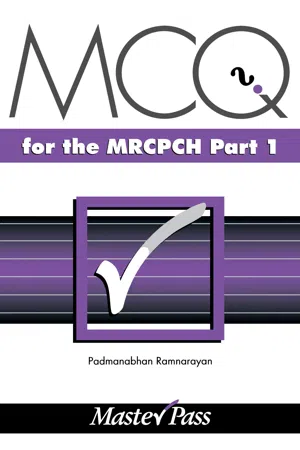
This is a test
- 150 pages
- English
- ePUB (mobile friendly)
- Available on iOS & Android
eBook - ePub
MCQs in Paediatrics for the MRCPCH, Part 1
Book details
Book preview
Table of contents
Citations
About This Book
Here is a collection of multiple-choice questions for the Membership of The Royal College of Paediatrics and Child Health Part 1 examination. There are over 300 questions organised into 10 sections and the mixture of questions attempts to reflect the wide range of topics in the current syllabus. Each question has an explanatory answer, making this book an ideal revision guide for the MRCPCH examination.
Frequently asked questions
At the moment all of our mobile-responsive ePub books are available to download via the app. Most of our PDFs are also available to download and we're working on making the final remaining ones downloadable now. Learn more here.
Both plans give you full access to the library and all of Perlego’s features. The only differences are the price and subscription period: With the annual plan you’ll save around 30% compared to 12 months on the monthly plan.
We are an online textbook subscription service, where you can get access to an entire online library for less than the price of a single book per month. With over 1 million books across 1000+ topics, we’ve got you covered! Learn more here.
Look out for the read-aloud symbol on your next book to see if you can listen to it. The read-aloud tool reads text aloud for you, highlighting the text as it is being read. You can pause it, speed it up and slow it down. Learn more here.
Yes, you can access MCQs in Paediatrics for the MRCPCH, Part 1 by P. Ramaranyan in PDF and/or ePUB format, as well as other popular books in Medicine & Medical Theory, Practice & Reference. We have over one million books available in our catalogue for you to explore.
Information
Section 1
1.1 Regarding fluid and electrolyte homeostasis in a child:
- Normal maintenance requirement in a child weighing 20 kg is 1.5 litre/day
- A fluid deficit of 50ml/kg produces a body weight loss of 10%
- Hypotension is a useful sign, which indicates moderate dehydration
- Normal maintenance needs of sodium are 5-6mmol/kg/day
- The characteristic metabolic abnormality in a child with pyloric stenosis is hyperkalaemic hypochloraemic metabolic alkalosis
1.2 Sequelae of a complete posterior cord section between C3 and Tl include:
- Muscle fasciculation
- Loss of sensation below the lesion
- Loss of deep tendon reflexes
- Athetoid movements
- Sympathetic pseudomotor problems
1.3 The following conditions are associated with hyperammon-a ernia:
- Reye syndrome
- Citrullinaemia
- Methylmalonic acidaemia
- Homocystinuria
- Isovaleric acidaemia
1.4 Membranous glomerulonephritis:
- Is typically associated with immune complex deposition
- Presents with nephritic syndrome
- Is associated with highly selective proteinuria
- Deposits of IgG on the glomerular membrane
- Carries a worse prognosis than minimal change disease
1.5 Common causes of jaundice in a 12-hour-old neonate include:
- Glucose-6-phosphate dehydrogenase deficiency
- Rhesus isoimmunisation
- Crigler-Najjar syndrome type II
- Choledochal cyst
- Breast-milk jaundice
1.6 Urinary tract infection:
- Usually leads to vesico-ureteric reflux
- Is more common in boys than girls under a year of age
- In boys, is most commonly caused by Proteus mirabilis
- Is associated with constipation
- Prevention is best achieved by long-term amoxycillin
1.7 Liver failure in children:
- Is always chronic in nature
- Wilson's disease is a common cause
- Leads to failure to thrive
- One of the causes is Reye syndrome
- Can result from unrecognised extrahepatic biliary atresia
1.8 Usual indications for an exchange transfusion in a child with sickle cell disease include:
- Painful vaso-occlusive crisis
- Splenic sequestration crisis
- Acute chest syndrome
- Dactylitis
- Priapism
1.9 Complications of an infant of a diabetic mother include:
- Hypoglycaemia
- Hypocalcaemia
- Hyperinsulinaemia
- Jaundice
- Hypomagnesaemia
1.10 Concerning SLE:
- Antibodies against double standard RNA are a typical finding
- Haematoxylin bodies occur in areas of inflammation
- Usually progresses to renal failure within two years
- Alopecia is a recognised finding
- Psychosis is a recognised presentation
1.11 Rett syndrome is characterised by:
- Social withdrawal
- Self-mutilation
- Macrocephaly
- Wringing hand movements
- Seizures
1.12 The following contribute to the natural immunity trans mitted in breast milk:
- Macrophages
- Natural killer cells
- Lysozyme
- Mast cells
- Secretory IgA
1.13 Clubbing is found in:
- Crohn's disease
- Bronchiectasis
- Rheumatic fever
- Inf...
Table of contents
- Cover Page
- Title Page
- Copyright
- Contents
- Preface
- Abbreviations
- Questions
- Section 1
- Section 2
- Section 3
- Section 4
- Section 5
- Section 6
- Section 7
- Section 8
- Section 9
- Section 10
- Answers
- Section 1
- Section 2
- Section 3
- Section 4
- Section 5
- Section 6
- Section 7
- Section 8
- Section 9
- Section 10
- Scoring Sheets